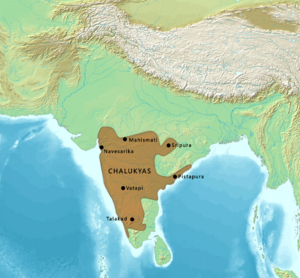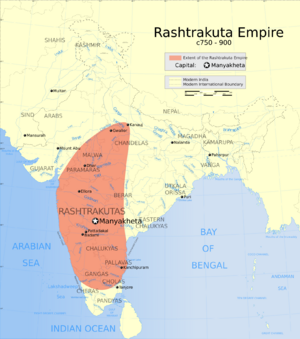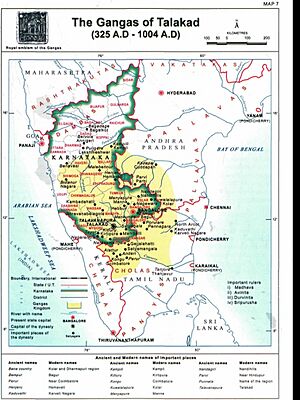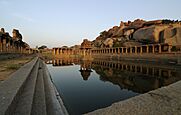History of Karnataka facts for kids
The History of Karnataka goes back thousands of years. Many powerful empires and rulers have shaped Karnataka. They greatly helped develop its history, culture, and the entire Indian subcontinent. Some early dynasties like the Chindaka Nagas, Gangas, Rashtrakutas, and Yadavas were from Karnataka. They later supported local languages.
In the medieval and early modern times, the Vijayanagara Empire and the Bahmani Sultanate became very strong in Karnataka. The Bahmani Sultanate later split into five different kingdoms called Deccan Sultanates. These sultanates worked together to defeat the Vijayanagara Empire in 1565.
Later, in the 17th and 18th centuries, the Maratha Empire controlled most of what is now Karnataka. Maratha rule was strongest in the northern parts. The first Maratha armies in this area were led by Chhatrapati Shivaji. As the Maratha power weakened in the 1780s, the Kingdom of Mysore started taking over lands in Southern Karnataka.
After the Anglo-Mysore Wars, where the East India Company defeated Tipu Sultan, the British Company began ruling parts of India. Karnataka was divided among the Bombay Presidency, the Kingdom of Mysore, and the Nizam of Hyderabad.
India became independent in 1947. According to the States Reorganization Act of 1956, the Kannada-speaking areas from Hyderabad State and Madras State joined with Mysore State. The state was renamed Karnataka in 1973.
Contents
- Ancient Karnataka: Early Humans and Tools
- Early Connections: Indus Valley Civilization
- Classical Period: First Kingdoms Emerge
- Middle Kingdoms: Great Empires of Karnataka
- Vijayanagara Era: A Powerful Empire (1336–1565)
- Bahmani and Deccan Sultanates: New Powers
- Maratha Era: Rise of a Warrior Empire (1674–1818)
- The Rise of Mysore: A Powerful Kingdom
- Independence Movement: A New Era
- Timeline
Ancient Karnataka: Early Humans and Tools
The first detailed studies of ancient Karnataka were done by Robert Bruce-Foote. Many other experts continued his work. The ancient culture of Karnataka (and South India) is known as the hand-axe culture. This is different from the Sohan culture of North India.
Old Stone Age tools have been found in Karnataka. These include hand axes and cleavers made from quartz. They were found in places like Lingadahalli in Chikkamagaluru district and Hunasagi in Yadgir district. A wooden spike was also found at Kibbanahalli in Tumkur district.
Towards the end of the Stone Age, people in Karnataka started using iron tools. These included long swords, sickles, axes, hammers, and arrows.
Life in the New Stone Age
Important New Stone Age (Neolithic) sites include Maski in Raichur district and Brahmagiri in Chitradurga district. These sites show that people began to domesticate animals like cows, dogs, and sheep. They also started using copper and bronze weapons. People wore jewelry like bangles, rings, necklaces, and earrings. They also built special burial chambers.
Early Connections: Indus Valley Civilization
Experts believe there were connections between the Indus Valley cities of Harappa and Lothal and Karnataka. This idea comes from the discovery of gold at Harappan sites. This gold was likely brought from mines in Karnataka.
Evidence of early human settlements in modern Karnataka was first found in 1872. These included tools called celts from around 200 BCE. There are also reports of a polished stone axe found at Lingsugur in the Raichur district. However, these reports are hard to confirm.
Large stone structures and burial grounds from the Megalithic age were found in 1862. These were in the regions of Kodagu and Moorey Betta hills.
Classical Period: First Kingdoms Emerge
Karnataka was once part of the Maurya Empire. This was a very large empire. The first Mauryan Emperor, Chandragupta Maurya, died in Shravanbelgola in Hassan District around 298 BCE. He spent his last days there as a Jain holy man.
Around 239 BCE, the Satavahana dynasty came to power. Their rule lasted for almost 400 years, until the early 3rd century CE.
The Rise of Native Kingdoms
When the Satavahana dynasty broke apart, the first native kingdoms of Karnataka appeared. These were the Kadamba Dynasty of Banavasi and the Western Ganga Dynasty in southern Karnataka. This marked the start of Karnataka as an independent political area.
The Kadambas and Western Gangas were the first kingdoms to use the Kannada language for official purposes. The Halmidi inscription from 450 CE, linked to King Kakusthavarma of the Kadamba Dynasty, shows this. Also, a 5th-century copper coin found in Banavasi, the ancient Kadamba capital, has Kannada writing on it. This further proves that Kannada was used officially.
Middle Kingdoms: Great Empires of Karnataka
After the early kingdoms, large empires rose to power. These included the Badami Chalukyas, the Rashtrakuta Dynasty, and the Western Chalukya Empire. Their main capitals were in the modern Karnataka region. They strongly supported the Kannada language and its literature.
Badami Chalukyas: Builders of Temples
The Badami Chalukyas ruled from the 6th to the 8th centuries. They built many famous temples.
Rashtrakutas: A Golden Age
The Rashtrakutas were initially under the Badami Chalukyas. But in 735 CE, Dantidurga overthrew the Chalukya ruler Kirtivarman II. This established the rule of the Rashtrakuta dynasty.
During this time, there were important advancements in literature, arts, and mathematics. Amoghavarsha I, the most famous king of this dynasty, wrote Kavirajamarga. This was a very important literary work in the Kannada language. Important mathematical ideas were also developed by Mahaviracharya.
Western Chalukyas: Continuing the Legacy
The Western Chalukyas ruled Karnataka between 973 and 1189 CE. They continued the traditions of art and literature.
Western Gangas: Patrons of Jainism
The Western Ganga dynasty began around 350 CE. They ruled southern Karnataka. They were independent until about 550 CE. After that, they ruled under the Badami Chalukyas, Rashtrakutas, and Western Chalukyas. Their rule ended around 1000 CE.
Even though it was a small kingdom, the Western Gangas made important contributions to the government, culture, and literature of southern Karnataka. The Western Ganga kings were tolerant of all religions. However, they are most famous for supporting Jainism. This led to the building of monuments in places like Shravanabelagola and Kambadahalli. These kings also encouraged fine arts, which helped Kannada and Sanskrit literature to grow.
Hoysala Empire: Art and Architecture Flourish
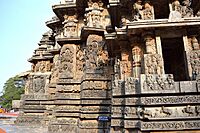
The Hoysalas were from the malnad region of Karnataka. They established the Hoysala Empire around the year 1000. Art and architecture thrived during this time. This led to unique Kannada literary styles and the building of temples and sculptures in the Vesara style. The Hoysala Empire grew to include large parts of modern Andhra Pradesh and Tamil Nadu.
Other Important Kingdoms
Other dynasties also ruled parts of Karnataka. These included the Seuna dynasty, the Kadamba dynasty, and the Chola Empire.
Vijayanagara Era: A Powerful Empire (1336–1565)
In the early 14th century, the Vijayanagara Empire rose to power. Its capital was Hosapattana, later called Vijayanagara. This empire successfully fought against Muslim invasions in the South. Harihara I and Bukka Raya established this empire. Many historians believe they were commanders of the last Hoysala King, Veera Ballala III. The empire thrived for over 200 years.
The Vijayanagara rulers supported culture. A special style of literature and architecture developed during this time. The best examples of Vijayanagara architecture can be seen in the ruined city of Hampi.
Battle of Talikota: The Empire's Fall
The main rivals of the Vijayanagara Empire were the five Deccan Sultanates. They defeated the empire in 1565 at the Battle of Talikota.
During the battle, two generals from the Vijayanagara army switched sides. They joined the united Sultanates. They captured Aliya Rama Raya, the Vijayanagara leader, and killed him. Rama Raya's death caused great confusion in the Vijayanagara army, which was then completely defeated. The Sultanates' army then looted Hampi and left it in ruins.
Bahmani and Deccan Sultanates: New Powers

The Bahmani sultans of Bidar were the main rivals to the Vijayanagara Empire. After the Bahmanis fell, the Bijapur Sultanate and Bidar Sultanate took their place. They continued the struggle for control of southern India.
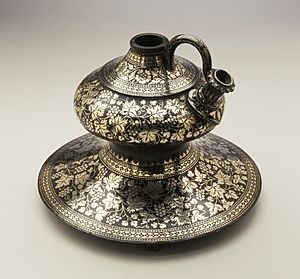
After the Vijayanagara Empire was defeated in 1565, the Bijapur Sultanate became the main power in the Deccan. However, they were later defeated by the Mughal Empire in the late 17th century. Mughal Emperor Aurangzeb ordered the siege of Bijapur. After a 15-month siege, the Mughal army won, and the Adil Shahi dynasty ended.
The Bahmani and Bijapur rulers supported Urdu and Persian literature. They also encouraged Indo-Islamic architecture. The Gol Gumbaz is a great example of their contributions. Unique art forms like Bidriware and Deccan painting also developed during this time. The Madrasa Mahmud Gawan was a university built during the Bahmani Sultanate's rule. It was one of the few centers for higher learning in medieval India.
Maratha Era: Rise of a Warrior Empire (1674–1818)
Most of Karnataka was conquered by the Maratha Empire in the 17th and 18th centuries. The first military expeditions were led by Chhatrapati Shivaji. After Shivaji's death in 1680, his son Chhatrapati Sambhaji became the Maratha ruler. He ruled until he was captured and executed by the Mughal emperor Aurangzeb in 1689.
From 1689 until 1707, a long war was fought in the Deccan, including Karnataka. The Mughals attacked the region many times but found it hard to conquer. The Maratha Empire continued to rule most of Northern Karnataka until 1818.
The Rise of Mysore: A Powerful Kingdom
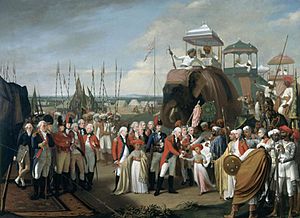
The Wodeyar family of Mysore were once under the Vijayanagara Empire. After the Vijayanagara Empire fell, Mysore became an independent kingdom in the 17th-18th century. When Krishnaraja Wodeyar II died, Hyder Ali, the army chief, took control. Later, his son Tipu Sultan became the ruler.
Tipu Sultan, known as the Tiger of Mysore, fought four major Anglo-Mysore Wars. He tried to stop European expansion in South India. The last war led to his death. Mysore then became a princely state under the British Raj.
After Tipu's fall, parts of the Mysore kingdom were taken and divided. They went to the Madras Presidency and the Nizam. The remaining area became a princely state. The five-year-old Krishnaraja Wodeyar III from the Wodeyar family was placed on the throne. Purnaiah served as his chief minister.
The Mysore State and Hyderabad State ruled most of Karnataka by the mid-19th century. They were allies with the British during the Indian Rebellion of 1857.
British Protectorate: Modern Changes
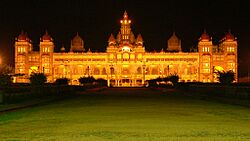
In 1799, the Kingdom of Mysore signed a treaty with the British Empire. This made Mysore a British Protectorate. The British then helped the Wadiyar dynasty return to power. During this time, railways and airways were introduced in the Kingdom of Mysore. Modern universities were also established. The Indian Institute of Science (1909) and University of Mysore (1916) were the first such institutions in Karnataka.
Independence Movement: A New Era
Even though the British helped the Kingdom of Mysore, the British period also brought challenges. There was racial discrimination and economic exploitation. Many famines occurred, especially in areas directly ruled by the British.
By the late 19th century, the movement for independence grew stronger. Leaders like Aluru Venkata Raya, S. Nijalingappa, Kengal Hanumanthaiah, and Nittoor Srinivasa Rau continued the struggle into the early 20th century. Strong independence movements also emerged in the parts of Karnataka directly controlled by the British.
Unification of Karnataka: A United State
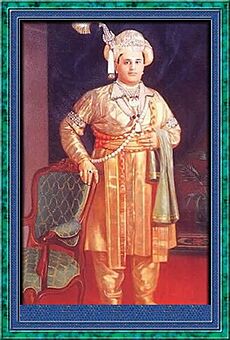
After India gained independence, the Wodeyar Maharaja joined India. In 1950, Mysore became an Indian state. The former Maharaja became its rajpramukh, or governor, until 1975.
The Ekikarana movement began in the mid-20th century. It aimed to unite all Kannada-speaking areas. This movement led to the States Reorganisation Act of 1956. This act brought parts of Coorg, Madras, Hyderabad, and Bombay states into the state of Mysore. Mysore state was renamed Karnataka in 1973. The state of Mysore was formed on November 1, 1956. Since then, November 1 is celebrated every year as Kannada Rajyotsava / Karnataka Rajyotsava.
Post-Unification: Modern Politics
The 1957 elections saw the Indian National Congress win many seats. S. Nijalingappa remained the Chief Minister.
The Congress party stayed in power in Karnataka until 1983. Then, the Janata Party formed the first non-Congress government in Karnataka. They had support from other smaller parties. Since then, power has switched between the Congress, Bharatiya Janata Party, and other parties in elections.
Timeline




